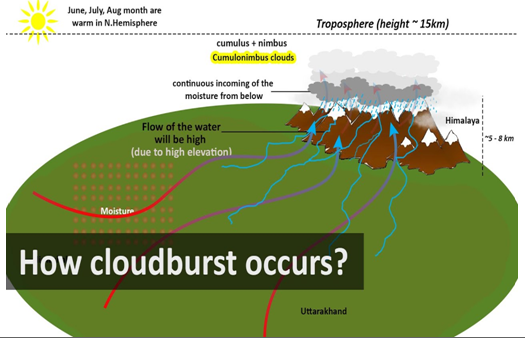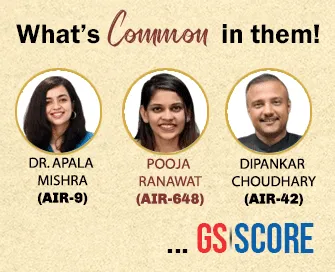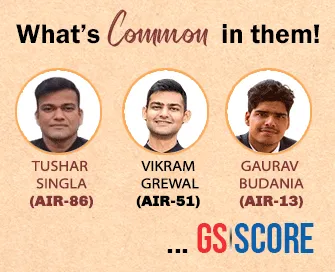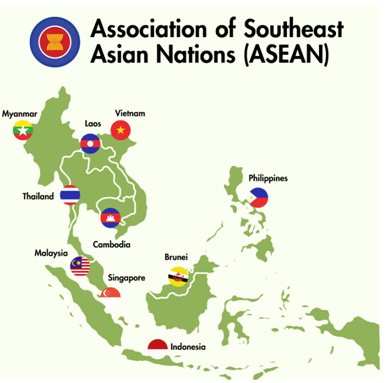

18th August 2025 (15 Topics)
Mains Issues
Context:
Five children among seven killed in cloudburst, landslide in Kathua.
Cloudbursts in India: Causes, Consequences, and Preparedness
Definition and Characteristics
- Nature of Event: A cloudburst is a sudden and highly intense rainfall event (?100 mm/hour over 20–30 km²).
- Cloud Source: Typically originates in cumulonimbus clouds between 1000–2500 m altitude under unstable, moisture-rich conditions.
- Langmuir Effect: Raindrops grow through coalescence until gravitational pull overcomes updrafts, leading to a sudden downpour.
Climatological and Geophysical Mechanisms
- Orographic Uplift: Moist air is forced upwards by hills, condensing rapidly into dense clouds.
- Airmass Convergence: Interaction of monsoon winds with dry air enhances vertical uplift.
- Instability and Low Pressure: Sudden temperature/pressure changes and regional depressions accelerate condensation.
- High Humidity and Lightning Delay: Excess moisture retention within clouds magnifies precipitation intensity.
Cloudburst-Prone Regions in India
- Himalayan States: Jammu & Kashmir, Himachal Pradesh, Uttarakhand, Sikkim.
- North-East India: Arunachal Pradesh, Meghalaya, Nagaland.
- Western Ghats: Kerala and Karnataka occasionally report such events.
Recent Examples
- Cloudburst-triggered Flash Flood in Chositi, Kishtwar (August 2025)
- Uttarkashi Flash Floods Following Cloudburst (5 August 2025)
- Mandi, Himachal Pradesh (July–August 2025)
- Himachal Pradesh (Kullu, August 2023)
- Uttarakhand (Rudraprayag, July 2023)
- Amarnath Yatra (J&K, July 2022)
- Ladakh (Leh, August 2010)
Hazards Associated with Cloudbursts
- Flash Floods: Torrents sweep away settlements, roads, and bridges in valleys.
- Landslides and Mudflows: Water-saturated slopes collapse, generating destructive slurry flows.
- Ground Subsidence: Excess pressure leads to sinkholes and hillside collapses.
- River System Impact: Riverbank erosion, course shifts, and temporary landslide lakes increase downstream flood risks.
Climate Change and Increasing Cloudburst Frequency
- Enhanced Atmospheric Moisture: Warmer air holds more water vapour, causing intense rainfall.
- Erratic Monsoon Patterns: Shorter, more intense rainfall episodes replace steady monsoon rains.
- Himalayan Vulnerability: Steep topography, fragile geology, and unplanned construction amplify disaster risks.
NDMA Guidelines on Cloudbursts
- Risk Mapping: GIS-based identification of hazard-prone zones.
- Radar Coverage Expansion: Installation of Doppler radars in vulnerable hill districts.
- Urban Drainage Planning: Design stormwater drains for short-duration high-intensity rainfall.
- Community Preparedness: Conduct mock drills, awareness campaigns, and early warning dissemination via SMS and sirens.
- Construction Regulation: Enforce slope-based building controls through micro-zoning techniques.
Way Forward
- Improved Prediction Systems: Adoption of high-resolution weather models and AI-based forecasting for localised rainfall.
- Strengthened Early Warning Mechanisms: Real-time monitoring networks in Himalayan States with siren/satellite-based alerts.
- Eco-sensitive Infrastructure: Restriction of construction in fragile slope zones, mandatory slope-stabilisation measures, and watershed management.
- Reforestation and Land Use Regulation: Afforestation to stabilise slopes and better land regulation to prevent unplanned expansion.
- Community Resilience: Training locals in evacuation, first aid, and relief operations to minimise casualties.


Mains Issues
Context:
Recent incidents of honour killings and rising caste-based violence in southern States, particularly Tamil Nadu, highlight the paradox of caste persistence amidst social justice movements and urban modernisation.
Caste paradox in India: Endurance of hierarchy versus forces of transformation
Persistence of Caste as a Social Phenomenon
- Deeply rooted institution: Caste is not merely an individual practice but a social system reinforced by families, communities, and cultural traditions.
- Transmission through family: Customs, rituals, and marriage alliances ensure caste continuity across generations.
- Psychological internalisation: Children learn caste boundaries early, making caste a lived reality rather than an abstract idea.
Honour Killings and the Caste Paradox
- Challenge of social mobility: Education and employment for Dalits have facilitated greater integration into mainstream society.
- Inter-caste marriages as flashpoints: Romantic unions across caste lines, especially involving Dalit men and dominant caste women, are seen as threats to entrenched hierarchies.
- Paradoxical violence:Honour killings are more prevalent in States with empowered Dalit populations (Tamil Nadu, Telangana, Maharashtra, Kerala), showing violence arises where caste dominance is challenged.
Tamil Nadu’s Experience
- Progressive civil society: Tamil Nadu has a strong anti-caste legacy shaped by social justice politics and democratic voices.
- Contradictory trends: Despite public rejection of caste killings, caste pride is often celebrated on social media under anonymity.
- Collective vs individual mindset: Public attitudes may appear progressive, but private family choices continue to perpetuate caste divisions.
Family as the Carrier of Caste
- Central role of family: Beyond politics, caste survives due to reinforcement within families through marriage arrangements and social expectations.
- Global comparisons: Shifts in family structures in South Korea and Japan show weakening traditional family units.
- Indian urban youth: Increasing focus on individual autonomy, emotional well-being, and self-prioritisation is slowly weakening the family’s hold and, consequently, caste enforcement.
Way Forward
- Strengthening legal measures: Strict enforcement of laws against honour killings and caste-based violence.
- Social reform campaigns: Promotion of inter-caste marriages through government schemes and civil society initiatives.
- Digital counter-narratives: Leveraging social media to dismantle caste pride discourses and amplify anti-caste voices.
- Educational transformation: Curriculum reform to encourage critical thinking against caste hierarchies.
- Cultural change: Long-term weakening of caste will come from shifts in family structures, lifestyle choices, and changing aspirations of youth.
|
PYQ: “Caste system in India is both a social reality and a political tool. Examine how it affects social harmony and democratic processes in India.” (2015) |


Mains Issues
Context:
Prime Minister Narendra Modi delivered his 79th Independence Day address from the Red Fort, presenting a long-term vision for a self-reliant, secure, and developed India by 2047.
Key Announcements and Themes
Strategic Autonomy and National Security
- Operation Sindoor: Demonstrated use of indigenously developed weapons in counter-terror operations.
- Indus Waters Treaty (IWT): PM declared that “blood and water will not flow together,” underlining India’s stand against providing resources to adversaries.
- Mission Sudarshan Chakra: Launch of an advanced indigenous weapon system to strengthen deterrence and ensure a nationwide security shield by 2035.
- High-Powered Demography Mission: Addressing illegal infiltration and safeguarding demographic integrity.
Atmanirbhar Bharat and Technological Sovereignty
- Semiconductors: First Made-in-India chip by 2025.
- Private participation in nuclear sector to enhance energy self-reliance.
- National Critical Minerals Mission: Exploration of 1,200 sites for securing strategic resources.
- National Deepwater Exploration Mission: Harnessing offshore energy for reduced import dependence.
- Indigenous Innovation Drive: Encouragement to youth for creating indigenous jet engines, social media platforms, fertilizers, and medical technologies.
Economic Reforms and Growth
- Next-Generation Economic Reforms:
- Abolition of 40,000 compliances and 1,500 outdated laws.
- Over 280 redundant provisions removed in recent sessions.
- Next-Generation GST reforms by Diwali to rationalize tax burdens and empower MSMEs.
- PM Viksit Bharat Rozgar Yojana: ?1 lakh crore employment initiative; newly employed youth to receive ?15,000 benefit, targeting 3 crore youth.
Energy and Nuclear Self-Reliance
- Achievement of 50% clean energy target by 2025, five years before schedule.
- Plans to increase nuclear capacity tenfold by 2047; construction of 10 new reactors underway.
- Assertion that import substitution in energy can redirect savings to farmer welfare.
Healthcare and Pharmaceutical Innovation
- Call for self-reliance in medicines and vaccines.
- Encouragement of indigenous patents in drug and medical technology sector.
- Example: India’s COVID-19 response (CoWIN platform and indigenous vaccines) as a model of innovation and global welfare.
Space and Innovation Ecosystem
- Indian space station preparations underway, following Gaganyaan mission.
- Growth of 300+ startups in satellite technology, space exploration, and allied domains.
Agriculture and Rural Economy
- India ranks 1 in milk, pulses, jute, and No. 2 in rice, wheat, cotton, fruits, vegetables.
- Agricultural exports crossed ?4 lakh crore.
- PM DhanyaDhanya Krishi Yojana launched for 100 backward districts to strengthen irrigation, crop productivity, and livestock protection.
Strengths of the Vision
- Strategic Autonomy: Focus on dismantling dependence on foreign defence and energy.
- Youth-Centric Growth: Employment scheme and innovation push to harness demographic dividend.
- Self-Reliance in Critical Sectors: From semiconductors to pharmaceuticals, an emphasis on indigenous production.
- Sustainability: Clean energy transition ahead of schedule; nuclear expansion for long-term stability.
- Holistic Security: Linking internal demographic security with external defence posture.
Challenges Ahead
- Implementation Gaps: Historical precedents show lag between announcements and on-ground delivery.
- Global Dependencies: Despite focus on self-reliance, global supply chain interlinkages in semiconductors, minerals, and energy remain critical.
- Fiscal Burden: Employment schemes and large-scale infrastructure missions may strain fiscal resources.
- Geopolitical Tensions: Indus Waters Treaty stand and counter-terror posture may escalate regional challenges.
Way Forward
- Ensure time-bound implementation of missions with transparent monitoring.
- Strengthen public–private partnerships in critical technology and defence.
- Balance self-reliance with global integration, avoiding isolationist tendencies.
- Expand investment in R&D and skilling to sustain innovation-driven growth.
- Adopt climate-resilient strategies in agriculture to maintain export leadership while addressing farmer welfare.


Mains Issues
Context:
India has achieved the 20% ethanol blending (E20) target in 2025, five years ahead of the original target under the National Policy on Biofuels.
Ethanol Blending in India
- Historical Progress: Ethanol blending rose from 5% in 2014 to 20% in 2025, supported by strong fiscal incentives to the sugarcane industry.
- Government Claim: Achieved multiple objectives — reducing greenhouse gas emissions, enhancing farmers’ incomes, and lowering oil import bill.
- Savings: Since 2014–15, India has saved ?1.40 lakh crore in foreign exchange through petrol substitution.
Consumer Perspective
- Vehicle Compatibility: All vehicles sold from 2023 carry E20 compatibility stickers. Older vehicles require modifications (rubbers, elastomers, plastic components).
- Public Reaction: According to LocalCircles survey, two-thirds of petrol vehicle owners oppose E20 citing lower mileage and higher maintenance costs.
- Government Stand: Admits marginal drop in efficiency, which can be minimized through engine tuning and material compatibility.
- NITI Aayog’s Suggestion: Proposed tax incentives on E10 and E20 fuels to compensate consumers.
Agriculture and Environmental Concerns
- Sugarcane Dependence:
- Ethanol supply increased from 40 crore litres (2014) to 670 crore litres (2024), using ~9% of sugar output.
- Farmers received ?1.20 lakh crore payments since 2015.
- Water Stress:
- 60–70 tonnes of water needed per tonne of sugarcane.
- Maharashtra’s sugarcane districts over-extract groundwater (CGWB 2023 report).
- Land degradation: 30% of India’s land degraded (ISRO’s Desertification & Land Degradation Atlas, 2021).
- Diversification Efforts:
- FCI allocated 2 MMT rice for ethanol (2025), up from <3000 tonnes earlier.
- 34% of corn output diverted to ethanol (2024–25), leading to 7 lakh tonnes corn imports.
- OECD–FAO projects 22% of India’s sugarcane for ethanol by 2034.
Economic and Trade Dimensions
-
- PSU Dividend Issue: Despite a 65% fall in oil prices, IOC & BPCL only reduced petrol prices by 2% while dividend payouts rose 255%.
- US Pressure: The S. has pushed India to relax ethanol import restrictions; India has resisted citing domestic investment in ethanol industry.
Ethanol vs EV Transition
- EV Advantage:
- EVs have greater potential for emission reduction and faster decarbonisation of transport.
- India’s EV share was 6% in 2024, needs to rise to 30% by 2030.
- Rare Earth Challenge:
- EV manufacturing dependent on REEs, largely imported from China.
- India imported 2,270 tonnes REEs (2023–24); supply disruption led to reduced EV production plans (e.g., Maruti e-Vitara).
Way Forward
- Consumer-Centric Approach: Introduce tax rebates/subsidies for ethanol-blended fuels to offset efficiency loss.
- Sustainable Agriculture: Diversify ethanol feedstock to less water-intensive crops (maize, sorghum, agricultural residues); promote 2G ethanol technologies.
- Balanced Energy Transition: Ethanol blending must complement, not substitute, the long-term EV transition.
- Trade Safeguards: Maintain import restrictions on ethanol to protect domestic producers.
- Water Governance: Strict groundwater extraction norms in sugarcane-growing states.
- EV Supply Chain: Develop indigenous rare earth processing capacity; invest in battery recycling and alternatives to reduce import dependence.
|
Ethanol Blending Programme (EBP)
National Policy on Biofuels (2018, amended 2022) Aim: Promote biofuels for energy security, farmers’ welfare, and environmental sustainability. Types of biofuels:
Salient Features:
|


Prelims Articles
Context:
Prime Minister Shri Narendra Modi paid homage to Sri Aurobindo, on the occasion of his birth anniversary
Sri Aurobindo:
Early Life & Education
- Birth: 15th August 1872, Calcutta.
- Educated in Darjeeling (Christian convent school) and later at the University of Cambridge.
- Mastered several European languages (including Latin, Greek, French, German, Italian) and Indian languages (Sanskrit, Bengali, Hindi, Gujarati, Marathi).
- Served in Baroda (Vadodara) State Service (1893–1906), first in administrative and later in teaching posts.
Role in Freedom Struggle
- Joined the Indian revolutionary movement after the Partition of Bengal (1905).
- BandeMataram (1906): English nationalist newspaper; advocated radical politics and swadeshi.
- Advocated purna swaraj (complete independence) long before Congress officially adopted it in 1929.
- Arrested in the Alipore Bomb Case (1908–09), but later acquitted.
- Emphasized direct action and armed struggle over petitions or reforms.
- Earned the title “Prophet of Indian Nationalism.”
Philosophical Contributions
- Believed human evolution is not yet complete; the next stage is the Supramental evolution.
- Philosophy focused on a synthesis of Eastern spirituality and Western rationalism.
- Advocated a divine life on earth, combining material and spiritual progress.
Literary Works
- BandeMataram (editorial writings in 1905–06).
- The Life Divine – his magnum opus, explaining Integral Yoga and supramental evolution.
- Savitri: A Legend and a Symbol – epic poem of nearly 24,000 lines (longest in English literature).
- Essays on the Gita – reinterpretation of the Bhagavad Gita.
- The Ideal of Human Unity – vision of global unity.
- Bases of Yoga, Rebirth and Karma, The Hour of God, The Future Evolution of Man.
Legacy
- Death: 5th December 1950, Pondicherry.
- Recognized as a yogi, philosopher, nationalist, poet, and visionary.
- Influenced Indian thought on nationalism, spirituality, and education.
- His vision of a divine, transformed society remains relevant in modern discourse on sustainable and holistic development.
- UNESCO celebrated his 150th birth anniversary in 2022 as an international commemoration.


Prelims Articles
Context:
Shri Sanjay Kumar, Secretary, Department of School Education & Literacy, flagged off 34 students from India to Japan under the Sakura Science Programme (17–23 August 2025).
Sakura Science Programme:
- Launched in 2014 by the Japan Science and Technology Agency (JST).
- Aims to promote youth exchanges in science and technology between Japan and Asian/African countries.
- India joined the programme in 2016; since then, 639 students and 93 supervisors have participated.
India’s Participation
- The 2025 batch includes 34 school students (13 boys and 21 girls) and 3 supervisors.
- Students are from government schools in Andhra Pradesh, Bihar, Delhi, Himachal Pradesh, Lakshadweep, Odisha, Puducherry, West Bengal, and NCERT’s RIE Demonstration Schools at Ajmer, Bhopal, Bhubaneswar, and Mysore.
- The programme supports the National Education Policy (NEP) 2020, which emphasizes experiential, holistic, and integrated learning.
Objectives and Significance
- Provides exposure to Japan’s advanced science, technology, and culture.
- Enhances bilateral ties between India and Japan, building people-to-people connections at a young age.
- Encourages students to imbibe values of punctuality, discipline, cleanliness, and innovation from Japan while showcasing Indian culture abroad.
Institutional Role in India
- Coordinated by the Department of School Education & Literacy (DoSEL), Ministry of Education, with NCERT support.
- Ceremony held at NCERT, New Delhi, with participation of senior MoE and NCERT officials.


Prelims Articles
NHAI has launched the FASTag Annual Pass facility on 15th August 2025 across 1,150 toll plazas to provide seamless and economical travel on National Highways.
About FASTag:
- FASTag is an electronic toll collection system in India, operated by the National Highways Authority of India (NHAI) under the Ministry of Road Transport and Highways (MoRTH).
- Uses Radio Frequency Identification (RFID) technology for automatic toll deduction without stopping at plazas.
- Introduced under the National Electronic Toll Collection (NETC) Programme.
FASTag Penetration:
- Currently, 98% penetration with over 8 crore users.
- Revolutionized highway toll collection by reducing congestion, fuel wastage, and cash transactions.
Annual Pass (New Facility):
- Applicable to non-commercial vehicles with valid FASTag.
- One-time fee: ?3,000.
- Validity: 1 year OR 200 toll plaza crossings (whichever is earlier).
- Activation: Within 2 hours through Rajmargyatra App/NHAI website.
- Benefits:
- Removes frequent recharge hassle.
- SMS alerts for “zero deduction” at tolls.
- Over 4 lakh passes purchased on Day 1.
- Grievance redressal: Toll plaza nodal officers + 1033 NH Helpline (strengthened with >100 executives).
Significance for Economy & Ease of Living:
- Supports Digital India, Ease of Living, and Green Mobility.
- Reduces congestion, emissions, and improves travel efficiency.
- Example of large-scale public digital infrastructure


Prelims Articles
Context:
On the 79th Independence Day, Prime Minister announced the launch of the Pradhan Mantri Viksit Bharat Rozgar Yojana (PMVBRY) with an outlay of nearly ?1 lakh crore to generate over 3.5 crore jobs in two years.
About the Scheme
- Launched in 2025 with an allocation of nearly ?1 lakh crore.
- Aims to generate 5 crore jobs in two years, with dual focus on first-time employees and employers.
- Incentives to be provided through Direct Benefit Transfer (DBT) and PAN-linked employer accounts.
Part A – Support to First-Time Employees
- Eligible for employees earning up to ?1 lakh/month and newly registered under EPFO.
- Incentive: Up to ?15,000 in two instalments (after 6 months and 12 months + completion of financial literacy programme).
- Benefit coverage: 92 crore first-time employees.
- Promotes financial inclusion by mandating savings in deposit instruments.
Part B – Incentives for Employers
- Applicable to all sectors, with emphasis on manufacturing.
- Incentive:Up to ?3000/month per new employee for 2 years; extended to 3rd and 4th year for manufacturing sector.
- Expected to support creation of 60 crore jobs.
- Aims at formalisation of workforce and wider social security coverage.


Prelims Articles
Context:
INS Tamal, the latest stealth frigate of the Indian Navy, concluded a port call at Naples, Italy highlighting India–Italy Strategic Partnership and bilateral defence cooperation.
INS Tamal – Indian Naval Asset
- INS Tamal is the latest stealth frigate of the Indian Navy, designed for reduced radar signature.
- Its deployment in European waters reflects India’s blue-water naval capabilities and maritime diplomacy role.
India–Italy Strategic Partnership
- Elevated in 2023 to a Strategic Partnership.
- A joint India–Italy Strategic Action Plan 2025–2029 has been launched to deepen cooperation in defence, technology, trade, and multilateral engagement.
Defence Cooperation
- INS Tamal conducted PASSEX (Passage Exercise) with ITS Trieste, Italy’s recently commissioned Landing Helicopter Dock (LHD).
- Exercises included communication drills, manoeuvres, flying operations, and sea rider exchange, followed by a ceremonial steam past.
Significance for India
- Enhances India’s Indo-Pacific outreach and naval presence in Europe.
- Reinforces India’s maritime diplomacy strategy of combining hard power (naval exercises) and soft power (cultural events).
- Strengthens interoperability and best-practices sharing between Indian and European navies.


Prelims Articles
Context:
India hosted the 10th Meeting of the ASEAN–India Trade in Goods Agreement (AITIGA) Joint Committee in New Delhi from 10–14 August 2025 to advance the review of the agreement.
ASEAN–India Trade in Goods Agreement (AITIGA):
- Signed in 2009 and came into force in 2010, it forms the legal foundation for trade in goods between India and ASEAN nations. The current review aims to make the agreement more trade facilitative, transparent, and mutually beneficial.
Importance of ASEAN for India:
- ASEAN accounts for around 11% of India’s global trade. Bilateral trade between India and ASEAN stood at USD 123 billion in 2024–25, highlighting ASEAN’s role as India’s key regional partner.
Institutional Framework:
- The AITIGA Joint Committee oversees the agreement’s functioning. Under it, 8 Sub-Committees exist, of which 7 met during the recent session. These sub-committees cover critical areas:
- Customs Procedures and Trade Facilitation (SC-CPTF)
- Legal and Institutional Issues (SC-LII)
- National Treatment and Market Access (SC-NTMA)
- Sanitary and Phytosanitary (SC-SPS)
- Rules of Origin (SC-ROO)
- Standards, Technical Regulations, and Conformity Assessment Procedures (SC-STRACAP)
- Trade Remedies (SC-TR)
Strategic Significance:
- The review aligns with India’s Act East Policy and aims to ensure greater market access, balanced concessions, and removal of non-tariff barriers.
|
ASEAN Establishment & Membership
Objectives
Key ASEAN Agreements & Initiatives
ASEAN–India Relations
|


Prelims Articles
Context:
On the occasion of the 79th Independence Day, Prime Minister highlighted the proposal for next-generation reforms in the Goods and Services Tax (GST), focusing on structural reforms, rate rationalisation, and ease of living.
About GST
- GST was implemented on 1 July 2017 through the 101st Constitutional Amendment Act, 2016.
- It replaced multiple indirect taxes (Central Excise, Service Tax, VAT, etc.) with a “One Nation, One Tax”
- Governed by the GST Council (Article 279A), chaired by Union Finance Minister, with States/UTs as members.
- It is a destination-based, value-added tax levied on the supply of goods and services.
Current GST Structure
- Multi-tier slab system: 5%, 12%, 18%, 28% (plus cess on luxury/sin goods).
- Special rates:0% for essentials, 25%/3% on specific items like diamonds, precious metals.
- Dual GST model:CGST + SGST/UTGST for intra-state supply, IGST for inter-state supply.
Proposed Reforms – Key Features
- Structural Reforms: Correction of inverted duty structures, resolution of classification disputes, and provision of long-term stability.
- Rate Rationalisation: Moving towards fewer slabs (two broad categories – standard and merit), lowering taxes on essential/common goods, and reducing slab complexity.
- Ease of Living & Doing Business: Seamless registration, pre-filled returns, faster refunds, tech-driven compliance.
- Fiscal Impact: End of Compensation Cess (introduced to compensate States for revenue loss until June 2022) creates fiscal space for reform.


Prelims Articles
Context:
Prime Minister highlighted the Khelo Bharat Neeti, a comprehensive framework aimed at strengthening the sports ecosystem at every level — from grassroots participation in schools and colleges to advanced athlete development.
Khelo Bharat Niti 2025
Policy Vision and Objectives:
- Khelo Bharat Niti 2025 integrates sports with the National Education Policy (NEP 2020), encouraging sports as a career and fostering lifelong fitness habits.
- It aims to position India among the top-10 sporting nations by 2036 and top-5 by 2047.
- Promotes inclusivity by focusing on women, marginalized groups, tribal communities, and persons with disabilities.
Institutional and Financial Support:
- Record allocation of ?3,794 crore for FY 2025–26 to the Ministry of Youth Affairs and Sports — a 9% increase since FY 2014–15.
- ?1,000 crore allocated to Khelo India Programme; support extended to athletes through scholarships, coaching, infrastructure, and allowances.
- Development of sports infrastructure projects worth ?3,124.12 crore and establishment of 1,045 Khelo India Centres and 34 State Centres of Excellence.
Khelo India Programme& Talent Identification:
- Khelo India Youth Games, University Games, Para Games, Winter Games, and Water Sports Festival promote mass participation.
- Khelo India Rising Talent Identification (KIRTI)programme uses 174 Talent Assessment Centres to scout children (aged 9–18).
- Integration of sports science, medicine, and technology for athlete training.
Long-Term National Goals:
- Strengthening National Sports Federations (NSFs)
- Expanding sports tourism, sports startups, and PPP/CSR investments for sustainable growth.
- Building the case for India’s bid to host the 2036 Olympics.


Editorials
Context:
The debate on the Archaeological Survey of India’s (ASI) outdated conservation practices has revived the demand for a new framework that integrates social, ecological, and economic dimensions.
Historical Foundations and Present Challenges
- Colonial Legacy of Conservation: British officers catalogued monuments, enacted preservation laws, and shaped procedures such as John Marshall’s Conservation Manual (1923), which promoted structural repairs and landscaped gardens.
- Current ASI Practices: Present conservation of nearly 3,600 ASI-protected sites continues to rely heavily on colonial-era frameworks, with irregular implementation of the 2014 Conservation Policy.
- Emerging Issues: Despite laws and international agreements, surveys and audits reveal many monuments are deteriorating, leading the government to invite corporations under the “Adopt a Heritage” scheme.
Towards a New Conservation Manual
- Gandhian Lessons for Conservation: Inspired by Sarvodaya, Gandhi emphasised that conservation should improve not only the monument’s structure but also the social and economic life of surrounding communities.
- Dialogues Across Disciplines: Translators, health professionals, biologists, mycologists, and economists offer fresh perspectives on repair, preservation, and restoration, enabling multi-disciplinary principles for a revised manual.
- Evolving Interpretations: Like translators who adapt texts over time, archaeologists must periodically review preservation materials and clearly distinguish modern interventions from the original monument fabric.
Integrating Ecology, Economy, and Citizens
- Ecological Linkages: Conservation must consider surrounding ecosystems—linkages with water bodies, fields, and forests—rather than isolating monuments behind walls.
- Economic Dimensions: Value lies in functionality, e.g., restoring natural ventilation systems over mere cosmetic repainting; economists’ concepts like creative destruction can guide innovative conservation strategies.
- Citizen’s Role: Citizens must learn to interpret monuments, amplify silenced histories, and treat India itself as a “monument without walls,” ensuring inclusivity in preservation.
Practice Question:
“India’s conservation practices remain bound by colonial legacies, demanding a shift towards socially inclusive, ecologically sensitive, and economically viable approaches.” Critically examine this statement in light of the need for a new ASI conservation manual. (250 words)


Editorials
Context:
Prime Minister Narendra Modi’s recent visit to Namibia, the first in nearly three decades, has underlined India’s evolving Africa policy and the scope for deeper bilateral engagement.
Foundations of Engagement
- Cultural Diplomacy and Symbolism: Prime Minister Modi’s use of Namibian cultural symbols and local language reflects India’s grounded approach, contrasting with the West’s conditional aid-driven engagement.
- Historical Solidarity: India anchors diplomacy in anti-colonial heritage, recalling its support for Namibia’s liberation movement and Lieutenant General Diwan Prem Chand’s UN role in Namibia’s transition.
- Continuity of Engagement: These reminders highlight India’s long-term commitment, offering an alternative to the episodic and transactional engagement of other global powers.
Present Dimensions of Cooperation
- Economic and Trade Linkages:Bilateral trade stands at $800 million, complemented by India’s $12 billion development partnership across Africa, reflecting steady economic growth.
- Capacity-Building Initiatives: Projects like the India-Namibia Centre of Excellence in IT and the India Wing at the University of Namibia enhance youth skill development and digital readiness.
- Technology Diplomacy: Namibia’s adoption of India’s Unified Payments Interface (UPI) as the first African nation showcases India’s export of digital public infrastructure and regulatory models.
Future Prospects and Challenges
- Strategic Importance of Namibia: Namibia’s political stability, mineral resources, and alignment with India on global economic reforms make it a key partner in shaping Global South narratives.
- Gaps in Implementation: Despite symbolic achievements, the visit yielded limited outcomes, with no concrete framework on critical minerals like uranium, essential for resilient low-carbon supply chains.
- Way Forward: The upcoming India-Africa Forum Summit offers an opportunity to institutionalise cooperation, but India’s credibility will depend on consistent follow-through and sustained investments.
Practice Question
“India’s engagement with Africa is shifting from symbolism to structured cooperation. In this context, critically evaluate the significance of India’s partnership with Namibia in advancing both bilateral and Global South priorities.” (250 words)


Editorials
Context:
The Trump–Putin Alaska Summit has raised debates on peace in Ukraine, territorial concessions, and the implications of secondary tariffs on India and global geopolitics.
US–Russia Diplomatic Realignment
- Trump’s Enduring Position: Across campaigns in 2016, 2020, and 2024, Donald Trump consistently emphasized the need for better ties with Russia, despite criticism at home and abroad.
- The Alaska Summit Context: The summit marked a shift from escalation toward dialogue, with Trump signaling recognition of battlefield realities in Ukraine.
- Statements on Peace Process: Trump acknowledged Russia’s strength in Ukraine and underlined the need for a ceasefire and peace arrangements, though territorial concessions remain a key sticking point.
European and Ukrainian Reactions
- European Reservations: Europe, although briefed by Trump, has not endorsed territorial concessions and continues to uphold Ukraine’s security guarantees.
- Ukraine’s Vulnerability: Kyiv faces pressure, as US disengagement could weaken resistance against Russia, despite promises of continued support.
- Strategic Choices for Europe: Europe must balance support for Ukraine with its limited defense capacity, while also navigating changing US commitments.
Global and Indian Implications
- Shifts in Global Diplomacy: The Alaska Summit highlights how US foreign policy flexibility can reshape NATO, European security, and global alignments.
- Impact on India–US Trade: India faces uncertainty due to mixed US signals on secondary tariffs, including the risk of a 50% levy on Indian exports to the US.
- Need for India’s Diplomatic Strategy: India must prepare a comprehensive economic and diplomatic response to mitigate tariff shocks while preserving strategic autonomy.
Practice Question
“The Alaska Summit has revived debates on US–Russia relations, European security, and global trade dynamics. Critically analyze its implications for India’s strategic and economic interests.” (250 words)





